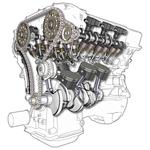See What Happens Inside your Engine
“ In the most basic definition, an internal combustion engine is nothing more than an air pump. Air is drawn in on one end, mixed with fuel and ignited (internal combustion), and forced out the exhaust. The engine converts the energy from combustion into the mechanical power to drive the vehicle. Let’s take a closer look .“
History of the Internal Combustion Engine
The internal combustion engine works due to the combustion that takes place in a confined space, of a fuel which produces expanding gases. Gases that are used directly to provide mechanical power.
History behind it is complex, with various scientists and engineers contributing to its development. Development starting from 1791 when John Barber developed a turbine all the way to 1872 when George Brayton invented the first commercial liquid-fueled internal combustion engine. There are multiple types of engines, however the most familiar one is the reciprocating, spark-ignited, four-stroke gasoline engine we use nowadays in everything from lawn mowers and chainsaws all the way to automobiles and yachts.
Components that make up an engine
There are numerous components that make it up and in general, all engine components are essential in ensuring it functions properly. These components are similar in both gas and diesel powered cars. At the moment we will focus on a few of the more important components:

- Cylinder Block (is the housing where all engine components are found. Built from metal and made to withstand rigors of engine torque and vibration. It is a complicated component, part of the heart of the engine).
- Carburetor or Fuel Injection/throttle body ( it’s the heart of an automobile. It meters and mixes fuel and air in the perfect proportion before distributing it to the engine. Or in the case of fuel injectors, sprays just the right amount of fuel at the right time before the piston compresses).
- Piston (a vital component responsible for compressing the fuel and transmitting power created by exploding fuel).
- Timing Belt (a cogged, rubber belt with teeth that ensures a quiet and flexible connection between all components that need to work together in perfect synchronization).
- Oil Pump (keeps a steady flow of oil over the moving components to prevent wear and tear).
- Water Pump (keeps a steady flow of cool liquid inside the engine to ensure that it doesn’t overheat).
- Spark Plug (an important component which has the primary function of igniting the air/fuel chamber).
How it looks at work? Let’s see
Watch this interesting clip made by Warped Perception. It goes through various examples and it’s worth watching to the end…
Is that going on in my car’s engine?
YES. This interesting clip portraits exactly what is happening in your car or truck’s engine. From intake and compression all the way to ignition and exhaust. This is the magic that is happening under the hood and that generates the power we need to go from A to B. Same principles are behind both gas and diesel powered engine. Only difference being that the latter on relies on compression instead of a spark from the spark plug.
As you seen in the video, the burning of fuel is interesting. It generates mechanical power but also generates a type of post-burning residue known to all of us as exhaust gas. Before it completely exits the engine, part of it builds up on internal components and creates the so called soot or carbon.
This is totally normal in a functioning engine, so nothing to be scared about. Partly to blame is the fuel that doesn’t always have the best quality chemical mixture or quality. Also, internal combustion engines never manage to burn fuel at 100% of it’s rate. Therefore we currently look after our engine by using various products from the market created to enhance engine fuel system capabilities and ensure better fuel burning and efficiency.
Forgive our shameless plug of one such product… CleanBoost® Maxx™ 16 oz. A fuel supplement and catalyst that treats the fuel and makes it more efficient. In a nutshell, the catalyst within CleanBoost® Maxx™ works to make fuel burn with more BTU’s, which is energy. With a very concentrated formula, it treats up to 30 gallons of fuel with just 1 oz of supplement.
Formulated as a combustion improver, it maximizes both performance and fuel economy acting also as a fuel efficiency booster which helps to reduce these combustion carbon deposits. This last part ensures that soot deposits are dramatically eliminated and gas emissions are overall reduced.
Performance wise it enhances both torque as well as horsepower and tests concluded that it can increase MPG up to 10%. The engine runs better and more efficient therefore less stress and wear is inflicted to the internal components!
About the Author
Tech Guy
Automotive enthusiast, passionate about Jeeps, hot-rods, turbos, performance, efficiency, diesels, fuels, high performance oils, additives and anything with an engine.

